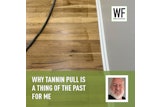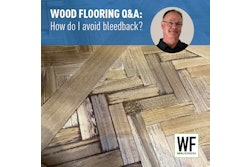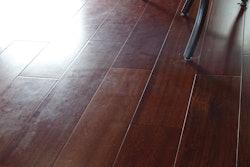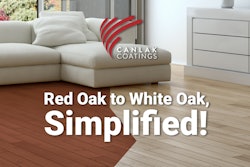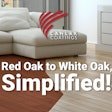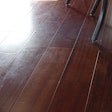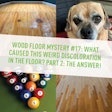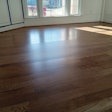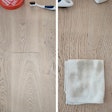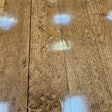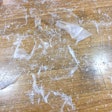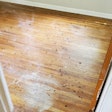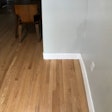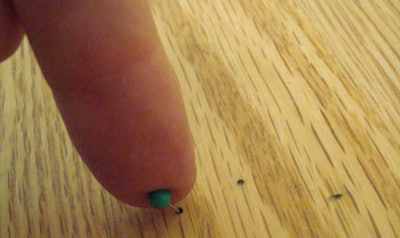
Battling Bugs?
 Pin worm holes are allowable in almost all grades of wood flooring.
Pin worm holes are allowable in almost all grades of wood flooring.
My customer says his floor has powderpost beetles. How do I know if he really has them?
Mickey Moore of Memphis-based Wood Flooring Advisors answers:
Active powderpost beetle infestations happen but are uncommon. An active infestation will have holes from about 1/32 to 1/16 inch in diameter, and the interior sides of the holes will be a bright raw wood color, as opposed to having stain or finish in them. The adult exit holes will also be nearly vertical to the face of the flooring. The most important sign of an active infestation is a small ring of powder called frass, which is the wood the beetle chewed up, around the hole. This frass will be very fine, like the consistency of talcum powder. You might also see one of the actual bugs, which are usually from 1/16 to 1/8 inch long.
 Little rings of wood powder called 'frass' are evidence of an active powderpost beetle infestation in a wood floor.
Little rings of wood powder called 'frass' are evidence of an active powderpost beetle infestation in a wood floor.
Beetle larvae only eat sapwood and hatch from eggs laid in the open pores of unfinished wood. Proper kiln drying will kill all stages of the insect, including the larvae, pupae, egg, and adult, so infestations typically happen at some point when the wood flooring was stored before installation. New infestations can occur in a home if the unfinished flooring is exposed for a long time or a resident beetle finds a gap between boards or at an end joint, such as by the baseboard. Infestations can occur from other infested materials in the house, like a wicker basket.
Most commonly, when people think they have powderpost beetles, what they are seeing are actually pinworm holes. Pinworm holes are allowed in all grades of unfinished flooring. Sometimes these holes are revealed over time as the finish wears or breaks over the holes, causing the appearance of new holes in the floor.
'Normal' Dents & Scratches
My customer is upset that the Brazilian cherry factory-finished floor I installed recently now has some dents in it. How can I convince her that this is normal?
David Harrison, inside sales specialty flooring expert at the Norcross, Ga., branch of Custom Wholesale Floors, answers:
The truth is that all wood floors get dents and all finishes get scratches. So now the real issue is: How deep of a dent are you willing to tolerate? Sometimes I think people forget that wood floors also serve a very utilitarian function; they get walked on and used probably more than any other product in the house, and this will result in scratches and dents.
A lot of this can be avoided by consulting with the customer about the preventive measures they should take to minimize these occurrences: proper placement of mats, being aware of the types of shoes that come into your home, having a walk-off mat outside and inside each doorway, and putting floor protectors on every single leg of every table and chair.
Most of the complaints I have seen that involve dents and scratches seem to have the same initial description: "My floor scratches too easily." How can you possibly qualify that? The floor is only going to scratch when something abrasive is ground against it, and it is only going to dent when something heavy (and this is relative also) is dropped on it. Or it will take only one friend wearing high heels with worn pads exposing the nail in the heel; I don't know any wood floor that would hold up to that. Buying a wood floor that has a higher impact resistance (Janka) number is not going to prevent dents entirely, and there is not one finish out there (that I know of) that will not scratch. The real answer is preventative education of the customer so that they can take the proper precautions to protect their floors.
Blotchy Stain
I used wood conditioner when staining a maple floor, but it still turned out blotchy. What did I do wrong?
Johannes Boonstra, sales and technical support supervisor at Synteko Floor Finishes and Liquid Nails Adhesies, answers:
You can use wood conditioner as a control to reduce the blotchy appearance of stain on woods with irregular grain texture like maple or pine. The problem is that most don't know how to use it properly.
First, when using an oil-based stain, you need to use an oil-based wood conditioner. Apply a generous "soaker coat" (it's very important not to apply it too dry/thin) of the conditioner, being sure not to miss any areas. Allow it to absorb and wipe or buff off the excess that does not penetrate before the conditioner starts to dry. Next, the oil-based stain needs to be applied immediately or as soon as possible, but at least within two hours after the conditioner application. (When the conditioner dries too long, that is often the cause for an excessively blotchy appearance.)
Keep in mind that the proper use of wood conditioner will provide a more uniform appearance but will also result in a significantly lighter color compared to an application of that color on untreated wood. So, the use of conditioner is often not a good option unless a lighter color is desired. (Remember that second coats of stain to achieve a darker color are never a good idea on hardwood floors.) Sanding the floor properly and water-popping before stain is a better choice to control a blotchy appearance.









